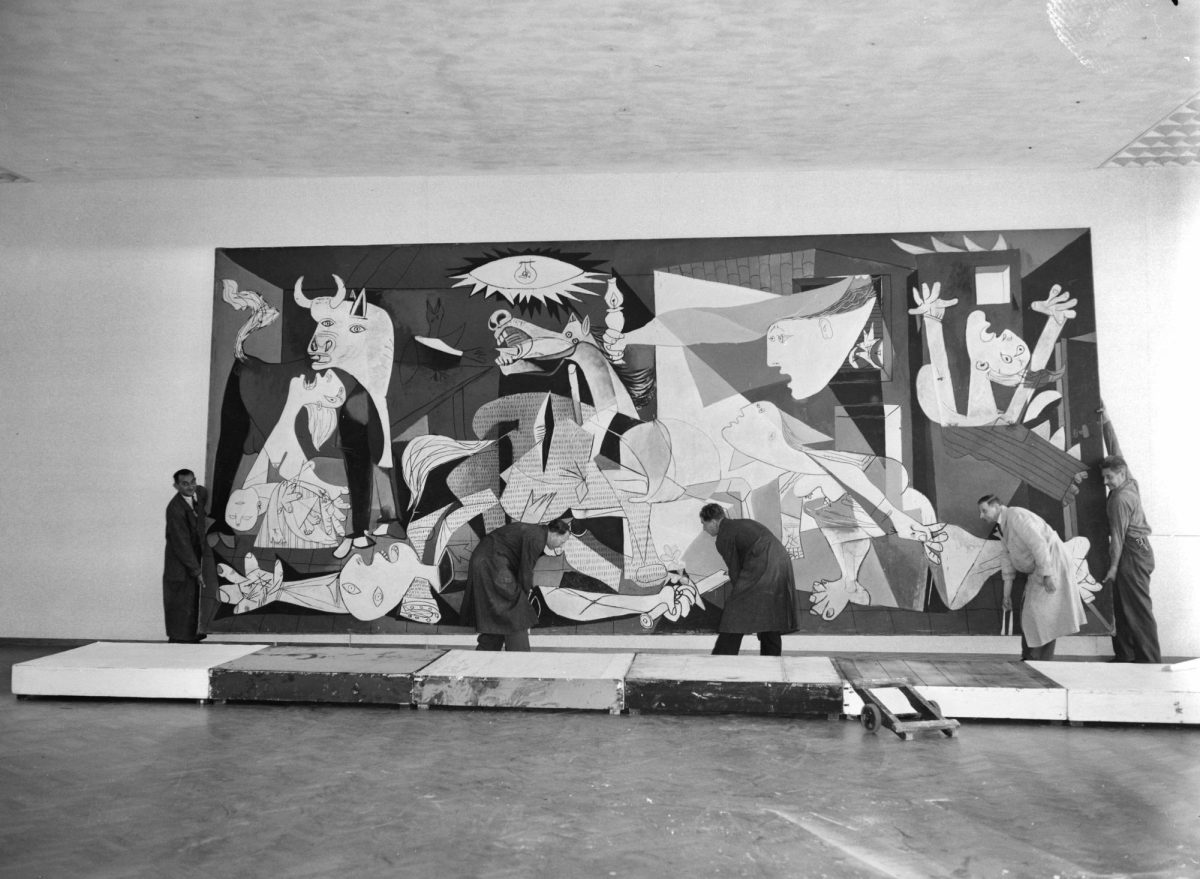In the pantheon of anti-war artwork, one of the most notable works is Pablo Picasso’s painting Guernica. Since its creation in the 1930s, Guernica has endured as a powerful symbol of protest against violent conflict around the world.
At 25 feet in length and 11 in height, Picasso’s mural is no small feat. The painting—originally commissioned by a newly elected Spanish government and displayed in the Spanish Pavilion at the 1937 World’s Fair—was a surprisingly political take on the events at Guernica during the Spanish Civil War on the 27th of April, 1937.
In an inhumane and brutal military training mission, Hitler’s German air force (in support of Francisco Franco, the leader of the Spanish Nationalist Forces during the Spanish Civil War, and later dictator of Spain from 1939 to 1975) tested new bombing tactics on the Spanish village of Guernica. The village held little to no strategic value to the war and the attack killed an estimated 1,650 civilians.
In response to this event, Pablo Picasso painted Guernica in a single month. Visually, it provides the viewer with an overwhelmingly chaotic and seemingly unstructured mess of death, pain, and grief. Picasso’s cubist style provides various viewpoints and a cacophony of obscure intersections of forms and images that serve to perplex the viewer. The piece provides no evident focal point and engulfs the viewer with so many images, both abstract and literal, that make the artwork difficult to digest.
However, upon closer inspection, the painting is divided into several vertical sections, with distinguishable figures appearing in each, as well as a distinct triangle of light brightening the center of the piece.
Arguably the most emotionally impactful depiction in the piece is a woman to the far left of the painting, head back and screaming in grief, clutching a child who is assumed to be dead. Three more women can be seen to the right of the painting, each with increasingly twisted and contorted facial expressions. A wounded (or dead) man is also visible in the bottom left of the piece, with dismembered limbs scattered around him.
The piece displays a variety of symbols, though interpretations of these have been disputed since the production of the painting. A lightbulb appears near the center of the upper portion of the painting, which has been explained as either a criticism of the harsh reality of technological progress or as a symbolic representation of the bombs that tore the village of Guernica apart. A faded image of a dove is considered to symbolize the absence and deficiency of peace, while figures of a bull and a horse evoke images of war, bullfighting, or the suffering of innocents.
Ultimately, the meaning of these symbols is up to the interpretation of the individual viewer. As Picasso himself claimed, “It isn’t up to the painter to define the symbols. Otherwise, it would be better if he wrote them out in so many words. The public who look at the picture must interpret the symbols as they understand them.” There is no single definite way to read the images in this piece.
Guernica was one of the rare paintings by Picasso with a distinct political motivation.The painting has come to be regarded as an anti-war icon, and its image has been evoked in many circumstances since. It was put to use as a war protest symbol during the Vietnam War, replicated in posters and banners presented by activists at the time.
In 1947, Ad Reinhardt, an American abstract painter, recreated Guernica in cartoon form for American publication P.M. with a caption stating that it was not “a simple poster or banal political-cartoon which you can easily understand (and forget) in a few minutes, but a design that diagrams our whole present dark age.”
Guernica is, however, far from the only impactful example of anti-war artwork. Recently, as the war between Ukraine and Russia continues, artistic protests have been sparked across the planet.
Banksy, the world-famous street artist, painted a series of murals depicting disturbing scenes, such as children playing on a metal tank strap, or a woman in hair curlers and her nightgown wearing a gas mask, on the streets of various Ukrainian cities.
Artists Against War (AAW) curated a gallery of posters, from which the profits help support Ukrainian artists and the charity “COME BACK ALIVE”, supporting Ukrainian armed forces.
Graffiti artists around the world have been showing their support for Ukraine in their tags, some of which even include QR codes that lead to donation sites. In September of last year, ASIJ senior Yuno Inoue organized the Together4Ukraine event which included a fashion show featuring Ukrainian models.
Though the mediums and content of anti-war artwork may have evolved over the years, as long as war and conflict exist, anti-war art will follow. Some of the most emotionally and intellectually impactful pieces of art have been protests and statements on wars, and this fact will likely remain true for as long as we continue to witness wars and other violent political struggles.


